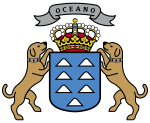Second Battle of Acentejo
| Second Battle of Acentejo | |||||||
|---|---|---|---|---|---|---|---|
| Part of the Spanish Conquest of the Canary Islands | |||||||
| |||||||
| Belligerents | |||||||
| Castile, Guanche and European allies | Guanches of Tenerife | ||||||
| Commanders and leaders | |||||||
| Alonso Fernández de Lugo | Tinguaro and Bencomo | ||||||
| Strength | |||||||
| 700 Castilians plus 800 Guanche allies | around 6,000 | ||||||
The Second Battle of Acentejo was a battle that took place on December 25, 1494, between the invading Spanish forces and the natives of the island of Tenerife, known as Guanches. The battle had been preceded by the Battle of Aguere, fought on November 14-15 of that same year, which had been a Castilian victory.
Advancing along the northern shores of the island, the Spaniards pursued the remaining Guanche forces and faced them once again at Valley of Taoro, near Acentejo, the site of the first battle, called by the Spaniards La Matanza ("The Slaughter").
Adelantado ("military governor") Alonso Fernández de Lugo divided his forces into two, with the Castilians bearing fire-arms taking the advantage. After three hours of fighting, the Guanches were defeated. Those who were not made prisoners of the Spaniards fled to the mountains.
With shouts of "Victory! Victory!" the Spanish forces celebrated their triumph, and Alonso Fernández de Lugo erected a hermitage in honor of Our Lady of Victory on the site of the battle. A town grew up around it, called La Victoria de Acentejo.
An old Canary Island pine, a witness to the battle, still stands in La Victoria de Acentejo. In its shadow the first mass was celebrated on the day of the battle. From its branches a bell was later hung, since the hermitage that Fernández de Lugo built in the same spot lacked a bell tower.
The mencey Bentor is said to have thrown himself from the heights of Tigaiga after learning of the outcome of the battle.
The Second Battle of Acentejo was certainly not the last battle on Tenerife between the Spaniards and the Guanches, but was certainly the most decisive, resulting in the ultimate incorporation of the island into the kingdom of Castile and the final subjugation of the aborigines.
Sources
- José Juan Acosta; Félix Rodríguez Lorenzo; Carmelo L. Quintero Padrón, Conquista y Colonización (Santa Cruz de Tenerife: Centro de la Cultura Popular Canaria, 1988), p. 51-2.
